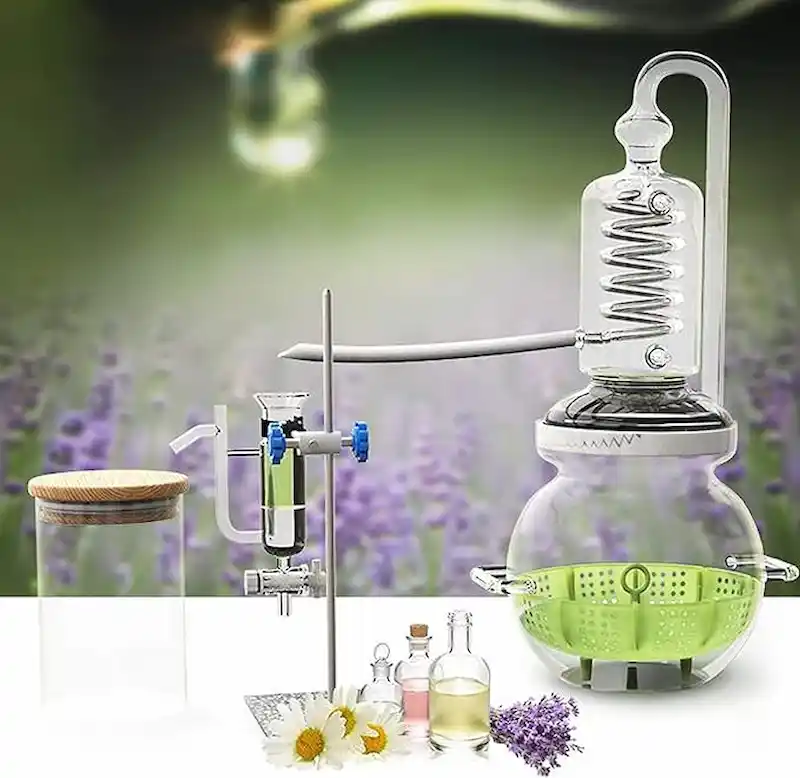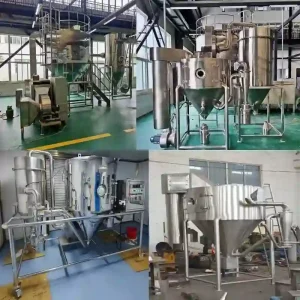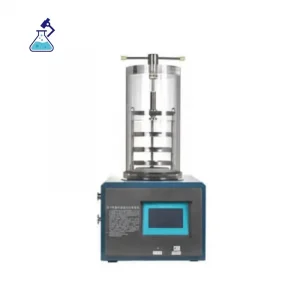Hydrosol distillers, the unsung heroes of natural remedies, have been quietly making waves in holistic well-being. As we delve into the fascinating realm of hydrosols, we uncover the myriad benefits and applications these distilled wonders bring to our lives. From healing properties to culinary delights, hydrosols are nature’s potent elixirs. This comprehensive guide aims to unveil the full potential of nature through hydrosol distillers, providing insights into their benefits, types, applications, and more.
I. Introduction of Hydrosol Distiller
A. Decoding the Art of Hydrosol Distillation
Hydrosol distillation, a method for extracting essential oils and floral waters from plants, captures nature’s essence in liquid form. It transcends traditional essential oil extraction, ensuring the preservation of plants’ therapeutic properties. The distillation process, often facilitated by hydrodistillation apparatus, herbal distillate makers, and steam distillation equipment, stands as a testament to the evolution of eco-friendly distillation technology.
B. Tracing the Ancient Roots of Hydrosols
With origins dating back centuries, hydrosol distillation has deep roots in ancient civilizations. From perfumery in Egypt to medicinal practices in Greece, the history of hydrosols is both rich and diverse. The aromatic water distillation process, an ancestral technique, laid the foundation for sustainable hydrosol production seen in today’s modern hydrosol manufacturing devices.
II. Understanding Hydrosols
A. Definition and Composition
Hydrosols are the water-based byproducts of the distillation process used to extract essential oils. Unlike essential oils, which capture the volatile oils of plants, hydrosols offer a gentler and milder form of botanical essence. Their composition includes water-soluble components and a trace amount of essential oil.
B. Extraction Process
- Distillation Techniques
Various distillation techniques contribute to the production of hydrosols, each influencing the final product’s quality and characteristics. Common methods include steam distillation and hydro-distillation, each with its nuances and advantages. - Importance of Quality Source Materials
The excellence of hydrosols begins with the selection of premium source materials. The type and quality of plants used significantly impact the hydrosol’s aroma and therapeutic properties.
III. Advantages of Utilizing Hydrosol Distillers
A. Purity of Natural Components
Hydrosol distillers guarantee the purity of natural ingredients, devoid of synthetic additives. This renders hydrosols perfect for those seeking an authentic and unadulterated connection with nature. The aqueous distillation system ensures that the resulting hydrosols maintain their pure, plant-derived essence.
B. Therapeutic Potency
In contrast to some commercial products, hydrosols maintain the therapeutic properties of plants. The gentle extraction process, facilitated by hydrosol separators and hydrosol condensation units, preserves the subtle fragrances and healing qualities. This natural fragrance distillation process is a key factor in the therapeutic potency of hydrosols.
C. Eco-Friendliness
Hydrosol distillation is an eco-friendly process, generating minimal waste and promoting sustainable practices. This aligns with the global shift towards eco-conscious living. The integration of hydrosol separator technology and hydrosol condensation units further emphasizes the commitment to sustainable hydrosol production.
IV. Varieties of Hydrosols
A. Floral Hydrosols
Derived from flowers, floral hydrosols boast delicate scents and diverse therapeutic benefits. Examples include rose, lavender, and chamomile hydrosols. The hydrosol manufacturing device plays a crucial role in extracting these floral essences.
- Rosewater
Renowned for its luxurious aroma, rosewater hydrosol carries the essence of roses. Its applications range from skincare to culinary delights, adding a touch of elegance. - Lavender Hydrosol
The calming and balancing properties of lavender extend into its hydrosol form. Widely used in aromatherapy, lavender hydrosol finds its place in promoting relaxation.
B. Herbal Essences
Extracted from herbs, these hydrosols offer a unique array of scents and medicinal properties. Popular choices include basil, sage, and thyme, making herbal distillate makers an essential component of hydrosol production units.
- Peppermint Hydrosol
With a refreshing and invigorating scent, peppermint hydrosol serves as a cooling agent. It finds applications in skincare and aromatherapy. - Chamomile Hydrosol
Chamomile, known for its soothing properties, translates these benefits into its hydrosol form. Ideal for sensitive skin, chamomile hydrosol is a gentle addition to skincare routines.
C. Citrus Infusions
Capturing the essence of citrus fruits, these hydrosols add a refreshing and uplifting element. Common varieties include lemon, orange, and grapefruit hydrosols, all achieved through the advanced technology of hydro steam distillers.
- Orange Blossom Hydrosol
The essence of orange blossoms captured in hydrosol form provides a delightful and uplifting fragrance. Its applications span from skincare to culinary creations. - Lemon Balm Hydrosol
Lemon balm hydrosol brings a burst of citrusy freshness, making it a favored choice in both skincare and aromatherapy.
V. Operational Mechanism of Hydrosol Distillers
A. Distillation Demystified
Hydrosol distillation employs steam to extract essential oils and aromatic waters from plants. This gentle process ensures the preservation of the plant’s essence. Essential equipment such as distillation kits, hydrosol condensation units, and hydrosol separators contribute to the efficiency of the distillation process.
B. DIY Hydrosol Distillation
For the adventurous, DIY hydrosol distillation is a rewarding endeavor, fostering a direct connection with the plants used and a deeper appreciation for nature. Utilizing plant essence extractors and hydrosol separators in a DIY setting offers a hands-on approach to the distillation process.
VI. Selecting the Right Flora for Hydrosol Distillation
A. Grasping Plant Properties
Before delving into hydrosol distillation, understanding the properties of plants is crucial. Each plant contributes unique qualities to the resulting hydrosol. This knowledge is fundamental for maintaining the purity and essence of the hydrosol.
B. Popular Plant Choices
Rosemary, lavender, and eucalyptus are favored picks for hydrosol distillation, each offering distinct aromas and therapeutic benefits. The floral essence separator becomes essential in capturing the nuances of these popular plant choices.
C. Tips for Distillation Success
Maintaining the right temperature and timing is essential for successful hydrosol distillation. Experimentation and observation play key roles in refining the process, ensuring the hydrosol condensation unit operates optimally.
VII. Integrating Hydrosols into Daily Life
A. Skincare Marvels
Hydrosols make excellent additions to skincare routines, serving as toners, facial mists, or enriching creams with their skin-nourishing properties. Aromatherapy distillation equipment aids in producing hydrosols that cater to various skin types.
B. Soothing Effects on the Skin
For those with sensitive or irritated skin, hydrosols offer a soothing touch. Whether used as facial mists or added to skincare formulations, they contribute to a calm and balanced complexion.
C. Emotional and Psychological Benefits
In the realm of aromatherapy, hydrosols offer a subtle and refreshing alternative to essential oils, finding versatile utility in diffusers or as room sprays to create a natural ambiance. The production of high-quality hydrosols is enhanced by floral essence separators. Beyond contributing to physical well-being, hydrosols profoundly impact emotions and mental states. Renowned for their calming effects, certain hydrosols, like lavender, prove invaluable in stress relief practices.
D. Culinary Enhancements
Certain hydrosols, like mint or citrus varieties, impart a unique flavor to culinary creations. They can elevate beverages, desserts, or even serve as a finishing touch to savory dishes. The versatility of hydrosols extends beyond the wellness sphere into culinary realms, showcasing the diverse applications of hydrosol extraction machines.
E. Antimicrobial Benefits
Hydrosols boast natural antimicrobial properties, making them excellent choices for skin care and wound care. Their gentle yet effective nature sets them apart in promoting skin health.
VIII. Hydrosols vs. Essential Oils
A. Distinguishing Features
While both hydrosols and essential oils originate from plants, they differ in concentration and composition. Hydrosols, being gentler and more versatile, prove suitable for various applications. The hydrosol separator becomes instrumental in ensuring the distinct features of hydrosols.
B. Synergistic Applications
Hydrosols and essential oils can complement each other. Leveraging them together, using hydrosol separators to finesse the extraction process, offers a holistic approach to aromatherapy and well-being. This synergy showcases the harmony achievable by combining natural fragrance distillation methods.
View more about Herbal distillate on Wikipedia






